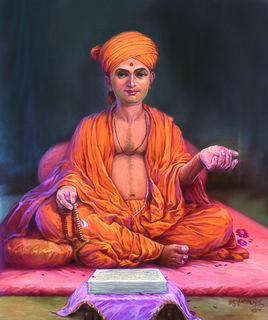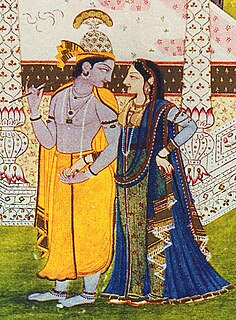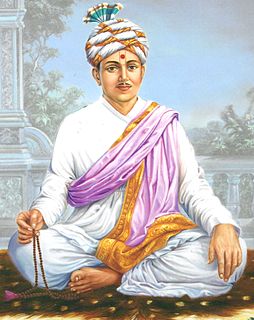This article has multiple issues. Please help improve it or discuss these issues on the talk page . (Learn how and when to remove these template messages)
|
A follower of Swaminarayan is referred to as a Satsangi [1]
This article has multiple issues. Please help improve it or discuss these issues on the talk page . (Learn how and when to remove these template messages)
|
A follower of Swaminarayan is referred to as a Satsangi [1]
A kanthi is a double stranded necklace made of tulsi. [2] Female satsangis are initiated by the wife of the acharya, who is the leader of women in the Swaminarayan Sampradaya. [3] Female members of BAPS are generally initiated by senior women followers and males are initiated at the hands of a sadhu or senior male devotees. [4]

Bochasanwasi Akshar Purushottam Swaminarayan Sanstha, is a Hindu denomination within the Swaminarayan Sampradaya. It was formed in 1905 by Yagnapurushdas following his conviction that Swaminarayan remained present on earth through a lineage of gurus starting with Gunatitanand Swami.

The Shikshapatri (Gujarati: શિક્ષાપત્રી, Devanagari: is a religious text consisting of two hundred and twelve verses, written in Sanskrit by Swaminarayan. The Shikhapatri is believed to have been written in the current form in Sanskrit by Satanand Swami, who incorporated into and compiled the scripture known as Satsangi Jivan. The Shikshapatri is a key scripture to all followers of the Swaminarayan Sampradaya and is considered the basis of the sect.

Pramukh Swami Maharaj was the guru and Pramukh, or president, of the Bochasanwasi Akshar Purushottam Swaminarayan Sanstha (BAPS), a major branch of the Swaminarayan Sampradaya, a Hindu denomination. BAPS regards him as the fifth spiritual successor of Swaminarayan, following Gunatitanand Swami, Bhagatji Maharaj, Shastriji Maharaj, and Yogiji Maharaj. He was believed by his followers to be in constant communion with Swaminarayan, and ontologically, the manifestation of Akshar, the eternal abode of Swaminarayan.

Swaminarayan, also known as Sahajanand Swami, was a yogi and ascetic around whom the Swaminarayan Sampradaya developed, and whose life and teachings brought a revival of central Hindu practices of dharma, ahimsa and brahmacarya. He is believed by followers to be a manifestation of God.

Yogiji Maharaj, born Jina Vasani, was a Hindu swami and the fourth spiritual successor of Swaminarayan in the Bochasanwasi Akshar Purushottam Swaminarayan Sanstha (BAPS), a major branch of the Swaminarayan Sampradaya. According to the metaphysics of BAPS, Yogiji Maharaj is considered to be the next iteration of Akshar after Shastriji Maharaj in the guru parampara, an unbroken line of "perfect devotees" who provide "authentication of office through Gunatitanand Swami and back to Swaminarayan himself." Together with Pramukh Swami Maharaj, who acted as the administrative head of BAPS, he was instrumental in nurturing the growth of BAPS "through new programs, expansion into new areas, and the construction of temples". As guru, he consecrated over 60 temples and visited over 4000 towns and villages. He was particularly effective in attracting the devotion of youths and initiated a large number of them as ascetics. Furthermore, his multiple tours to Britain and East Africa were integral in the overseas expansion of BAPS. He died on 23 January 1971 after appointing Pramukh Swami Maharaj as his successor.
The Laxminarayan Dev Gadi is one of the two gadis (diocese) that together form the Swaminarayan Sampraday. It is headquartered at the Shri Swaminarayan Mandir, Vadtal and controls the Dakshin Vibhag Lekh.

Gunatitanand Swami, born Mulji Jani, was a prominent paramhansa of the Swaminarayan Sampradaya who was ordained by Swaminarayan and is accepted as the first spiritual successor of Swaminarayan by the Bochasanwasi Akshar Purushottam Swaminarayan Sanstha (BAPS). Born into a religious family in the small farming community of Bhadra in Gujarat, India, he first received religious education under his father's guru, Ramanand Swami before encountering Swaminarayan and becoming a swami under him at the age of 25. He was revered for his spiritual discourses and divine service

Radha-Krishna are collectively known within Hinduism as the combined forms of feminine as well as the masculine realities of God. Radha and Krishna are the primeval forms of God and his pleasure potency respectively in several Vaishnavite school of thought.

Shastriji Maharaj, born Dungar Patel and ordained Shastri Yagnapurushdas, was a swami of the Swaminarayan Sampradaya and founder of the Bochasanwasi Akshar Purushottam Swaminarayan Sanstha (BAPS). Several branches accept him as the third spiritual successor of Swaminarayan in the lineage of Aksharbrahma Gurus through whom Swaminarayan manifests, which began with Gunatitanand Swami. Born in a family of farmers in central Gujarat, India, he became a swami within the Vadtal diocese of the Swaminarayan Sampradaya at the age of 17 where he was given the name Yagnapurushdas Swami. The prefix Shastri was later added in recognition of his eminent scholarship in Sanskrit and the Hindu scriptures. He established BAPS after a doctrinal split from the Vadtal diocese of the Swaminarayan Sampradaya.

The Urdhva Pundra is a tilak worn by Vaishnavites to show that they are devotees of Vishnu. It is generally worn on the forehead, but may also be worn on other parts of the body. The markings are made either as a daily ritual, or on special occasions, and denote the particular lineage or sampradaya to which the devotee belongs. The different Vaishnava sampradayas each have their own distinctive style of tilak based on the siddhanta of their particular lineage. The general tilak pattern is of two or more vertical lines resembling the letter U, which commonly represent the feet of Vishnu.

A shikharbaddha mandir is a traditional Hindu or Jain place of worship, typically featuring architecture characterized by superstructures with towers pinnacles and domes and often built of carved marble, sandstone, or other stone. While such mandirs are common in many branches of Hinduism, the use of the term shikharbaddha mandir to describe such mandirs is most common in the Swaminarayan branch of Hinduism as well as Jainism. The opposite of the shikharbaddha temple is one without a shikhara tower, i.e. with a flat roof.

Acharya Shree Tejendraprasadji Maharaj founded International Swaminarayan Satsang Organization (I.S.S.O.) in the United States on the occasion of Vijaya Dashami in the year 1978.
The Desh Vibhag Lekh was written by Swaminarayan in 1827 establishing the division of territory into two dioceses of Ahmedabad and Vartal

The Naranarāyan Dēv Gadī, named after NarNarayan Dev, is one of the two Gadis (seats) that together form the Swaminarayan Sampraday. Its headquarter is at the Shri Swaminarayan Mandir, Ahmedabad and controls the Uttar Vibhag.

The Swaminarayan Sampradaya, also known as Swaminarayan Hinduism and Swaminarayan movement, is a Hindu Vaishnava sampradaya rooted in Ramanuja's Vishishtadvaita, characterized by the worship of its charismatic founder Sahajanand Swami, better known as Swaminarayan, as an avatar of Krishna or as the highest manifestation of Purushottam, the supreme God. According to the tradition's lore, both the religious group and Sahajanand Swami became known as Swaminarayan after the Swaminarayan mantra, which is a compound of two Sanskrit words, swami and Narayan.

The Swaminarayan mantra, "Swaminarayan," is a mantra used by the Swaminarayan Sampradaya. It is a compound of two words: Swami and Narayan, that is, Vishnu c.q. Purushottam. According to the Swaminarayan-tradition, the Swaminarayan Mantra was introduced and explained by Swaminarayan, also known as Sahajand Swami, spiritual head of the Swaminarayan Sampradaya, shortly after the death of his predecessor, Ramanand Swami. Devotees chant the Swaminarayan mantra to offer worship, to allay distress, to pray for the welfare of others, and at the end-of-life. Several scriptures of the Swaminarayan Sampradaya, such as the Swamini Vato, Harililamrut, and Bhaktachintamani, describe the power and efficacy of the Swaminarayan mantra for one who chants it.

Satsangi Jivan is the authorised biography of Swaminarayan. The book contains information on the life and teachings of Swaminarayan. It is written by Shatanand Swami and completed in 1829. Swaminarayan decided to make Gadhada his permanent residence on the insistence of Dada Khachar and his sisters. Upon completion of the Shri Swaminarayan Mandir, Gadhada in 1828, Swaminarayan instructed Shatanand Swami to write a book on his life and pastimes.
A gaurav kanthi, or simply kanthi, is a necklace worn by some adherents of Hinduism.

Bhagatji Maharaj, born as Pragji Bhakta, was a householder devotee in the Swaminarayan Sampradaya, a Hindu denomination. He is regarded as the second spiritual successor of Swaminarayan in the Bochasanwasi Akshar Purushottam Swaminarayan Sanstha (BAPS).

Mahant Swami Maharaj is the present guru and president of the Bochasanwasi Akshar Purushottam Swaminarayan Sanstha (BAPS), a major branch of the Swaminarayan Sampradaya, a Hindu denomination. BAPS regards him as the sixth spiritual successor of Swaminarayan, following Gunatitanand Swami, Bhagatji Maharaj, Shastriji Maharaj, Yogiji Maharaj, and Pramukh Swami Maharaj. He is believed by his followers to be in constant communion with Bhagwan Swaminarayan, and ontologically, the manifestation of Akshar, the perfect devotee of God.